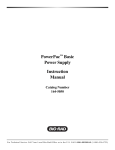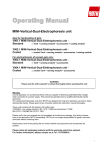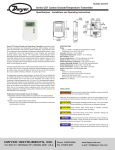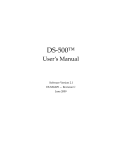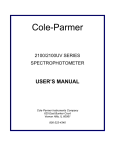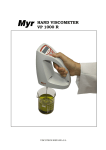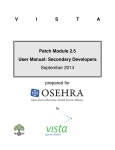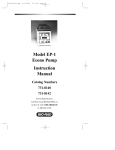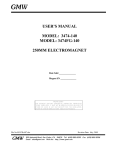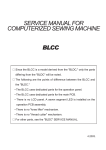Download PROTEAN Plus™ Dodeca™ Cell Instruction Manual - Bio-Rad
Transcript
PROTEAN Plus™ Dodeca™ Cell Instruction Manual Catalog Numbers 165-4150 165-4151 For Technical Service Call Your Local Bio-Rad Office or in the U.S. Call 1-800-4BIORAD (1-800-424-6723) Table of Contents Page Section 1 1.1 1.2 Section 2 2.1 2.2 2.3 2.4 General Information.........................................................................................1 Introduction............................................................................................................1 Safety .....................................................................................................................2 Setting up the PROTEAN plus Dodeca Cell for the first time ................3 Unpack the cell ......................................................................................................3 Components ...........................................................................................................3 Setting up the buffer recirculation pump ................................................................5 Additional required components ............................................................................7 3.1 3.2 3.3 3.4 3.5 3.6 Preparing for Electrophoresis ........................................................................7 Buffer preparation ..................................................................................................7 Gel preparation.......................................................................................................8 IPG Strips preparation and loading.........................................................................9 Cell assembly .............................................................................................10 Starting the electrophoresis run ............................................................................12 Removing the gel .................................................................................................12 Section 4 Maintenance .....................................................................................................13 Section 5 Troubleshooting Guide ..................................................................................14 Section 6 Product Information and Accessories ........................................................15 Section 7 Warranty Information ...................................................................................17 Section 3 Section 1 General Information 1.1 Introduction The PROTEAN Plus Dodeca Cell* is a multi-cell for polyacrylamide gel electrophoresis. It is primarily intended to run immobilized pH gradient (IPG) strips for the second dimension of 2-D electrophoresis. It runs one to twelve large format gels simultaneously. The PROTEAN Plus Dodeca cell system includes the Buffer Recirculation Pump that aids in maintaining a constant temperature during the electrophoresis experiment. This system uses the new PROTEAN Plus hinged spacer plates. These plates are strategically sealed at one side with a silicon strip to create a hinged cassette. The hinge is required to prevent current leakage and to achieve optimal results. Specifications of the PROTEAN Plus Dodeca Cell Tank and lid Anode Cathode Drain line Drain line connectors Cooling core Cooling core connector tubing Manifold tubing Buffer coil Gaskets Maximum buffer volume Minimum buffer volume Overall size (LxHxW) Tank and lid Pump Precast gel compatibility Handcast gel compatibility Hinged spacer plate dimensions Slab gel dimension Power safety limits Weight Acrylic Platinum-coated titanium plate electrode Stainless steel plate electrode Braided PVC Polypropylene Ceramic Braided PVC Tygon tubing 1/4" ID (required for PROTEAN II precast and handcast gels) Acrylic Silicone rubber 22.5 liters (plate width: 27cm) 16.8 liters (plate width: 20cm) 39.5 x 34.5 x 34.5 cm 19.5 x 12 x 17.5 cm PROTEAN II Ready gel precast gels with IPG comb PROTEAN Plus hinged spacer plates PROTEAN II 20 x 20 cm glass plates 26.8 x 22.5 cm; 26.8 x 20.5 cm 25 x 20.5 cm; 20 x 20.5 cm; 18.5 x 20 cm; or 18.3 x 19.3 cm 1000V, 250W 17.5 kg *Patent pending 1 Specifications of the Buffer Recirculation Pump Number of channels 1 Flow rate range 0 - 1.5 liters/min, as measured with 3/8" tubing and water. Flow rate will vary with tubing diameter, buffer viscosity, and line voltage. Maximum counterpressure ~ 10 psi Motor Self-priming oscillating pump Power requirements 120 VAC, 60 Hz 220 VAC, 50 Hz Maximum ambient temperature limit 40 °C Fuses required 100/120 V use .25 A type T 220/240 V use .125 A type T Dimensions 19 cm x 12.7 cm x 18 cm (W x D x H) Weight 2.9 kg Note: Dodeca cell components are not compatible with acetone or ethanol. Use of organic solvents voids all warranties. 1.2 Safety Power to the PROTEAN Plus Dodeca cell is supplied by an external DC voltage power supply (not included). The output of the power supply must be isolated from external ground to insure that the DC voltage output floats with respect to ground. All Bio-Rad power supplies meet this important safety requirement. Regardless of the power supply used, the maximum specified operating parameters for the PROTEAN Plus Dodeca cell are as follows: 1000 VDC voltage limit 250 watts power limit 40 °C ambient temperature limit The current to the cell enters the unit through the lid assembly that provides a safety interlock to the user. Always turn off the power supply before removing the lid. Do not attempt to use the cell without the safety lid. Important: This Bio-Rad product is designed and certified to meet *EN61010-1 safety standards. Certified products are safe to use when operated in accordance with the instruction manual. This instrument should not be modified or altered in any way. Alteration of this instrument will • Void the warranty • Void the EN61010-1 certification, and • Create a potential safety hazard Bio-Rad is not responsible for any injury or damage caused by use of this instrument for purposes other than those for which it is intended or by modifications of the instrument not performed by Bio-Rad or an authorized agent. *EN61010-1 is an internationally accepted electrical safety standard for laboratory instruments. 2 Section 2 Setting up PROTEAN Plus Dodeca Cell for the first time 2.1 Unpack the cell The complete PROTEAN Plus Dodeca Cell arrives in two boxes: The tank, lid, instructions and all required tubing are in one box, and the buffer recirculation pump is in a separate box. PROTEAN Plus hinged spacer plates and combs are ordered separately and are individually packaged. Carefully remove all components and inspect for damage. 2.2 Components To get the best performance from your PROTEAN Plus Dodeca cell, familiarize yourself with the components by assembling and disassembling the cell before using it. ANODE BUFFER EXHAUST TUBE CATHODE MANIFOLD TUBING MANIFOLD ELECTRODE CARD (ANODE) GASKET ASSEMBLY ELECTRODE CARD (CATHODE) BUFFER COIL CERAMIC COOLING CORE REFRIGERATED CIRCULATOR PATH Buffer tank and lid BUFFER RECIRCULATION PUMP PATH The buffer tank and lid combine to fully enclose the inner chamber during electrophoresis. The lid cannot be removed without disrupting the electrical circuit. 3 Ceramic cooling core Coolant from a refrigerated circulator passes through the ceramic cooling core to cool the buffer during the electrophoresis run. An ethylene glycol:water (20:80) solution is recommended as coolant. Buffer Recirculation Pump The self-priming oscillating pump pulls buffer from the top of the cell and refills from the bottom of the cell through the buffer coil to maintain a constant temperature in the cell. Buffer coil The buffer coil sits on the bottom of the Dodeca Cell. The small holes in the coil release buffer around the ceramic cooling cores and into the Dodeca Cell. Buffer exhaust tube The buffer exhaust tube connects to the lid of the Dodeca Cell via a quick-connect fitting. The other end connects to the inlet of the Buffer Recirculation Pump. Electrode cards Plate electrodes are attached to the electrode cards for easy removal. The anode is made of platinum-coated titanium and the cathode is made of stainless steel. DO NOT reverse the direction of the current, as this will damage the electrode. Gasket Assembly This assembly contains the rubber gaskets that hold the gel cassettes in position. The rubber gaskets are mounted on an acrylic support for easy removal. The tank has three positions for the gasket assemblies: a single position on the anode side and two positions on the cathode side to accommodate different gel sizes. Manifold The manifold in the lid is part of the buffer recirculation system. Manifold tubing The manifold tubing is required for proper buffer recirculation. The manifold tubing is eleven pieces of Tygon tubing that attach to the black fittings of the manifold in the lid of the Dodeca cell. The manifold tubing is necessary when running Ready Gel precast gels or handcast gels in PROTEAN II plates. These plates are shorter and therefore the buffer level is lower in the tank. Since the buffer level does not reach the black fittings, the manifold tubing is required to extend into the buffer so it can be properly recirculated. Note: ALL eleven pieces of tubing must be used when running any number of precast or handcast PROTEAN II gel cassettes. 4 PROTEAN Plus hinged spacer plate The hinged spacer plates close to form a gel cassette. The hinge is necessary to seal the bottom edge of the gel cassette so that the current pathway runs effectively through the gel. Caution: Glass plates and glass spacers are sharp. Gel releaser The green gel releaser tool is used to open the cassette after electrophoresis and to separate the gel from the bonded spacers. 2.3 Setting up the Buffer Recirculation Pump Carefully remove the Buffer Recirculation Pump from the shipping box. The pump includes a power cord and spare fuses. The Buffer Recirculation Pump is the key component of the Buffer Recirculation Pathway (BRP). The proper set up of the BRP is shown below in a schematic drawing (Figure 2.3A). The buffer exhaust tube connects from the the lid to the pump. The other end of the pump connects into the bottom of the cell. The BRP pulls buffer up through the lid and it flows down through the pump and back into the cell at the bottom of the tank through the acrylic tubes. Setting up the BRP in the inverse direction will result in inadequate buffer recirculation and the temperature throughout the tank will not be uniform. This will cause distortions in the protein resolution patterns in the gels. Fig. 2.3A. Proper Set-up of the Buffer Recirculation Pathway (BRP). 2.3.1 Voltage conversion The Buffer Recirculation Pump is shipped in its 120 V or 220 V version. To operate at other voltages, refer to the procedure below. Warning: Failure to follow this procedure may result in damage to the unit and invalidation of the warranty. Power is supplied to the Buffer Recirculation Pump via a power entry module consisting of: • On/off switch: A two-position rocker switch is located on the rear panel. “I” is ON, “O” is OFF. • Power cord receptacle: Grounded three-pin receptacle for the power cord • Fuse holder/line voltage selector: Four-position line voltage selector and fuse holder. 5 Prior to connecting the power cord to the power entry module and wall outlet, verify that the voltage indicated on the power entry module matches your line voltage. If it does not, follow this procedure to make the conversion. Using a screwdriver or similar tool, pry open the fuse holder cover. If necessary, replace the fuses with ones having the correct current rating. For 100 V and 120 V operation, ensure that two 0.25 A fuses are inserted in the upper and lower fuse holders. For 220 V and 240 V operation, insert two 0.125 A fuses into the fuse holders. Pull the voltage selector card located at the end opposite the power switch straight out from the housing. Do not damage the plastic indicator pin or the metal contacts on the selector card. The indicator pin can be moved across the slot located on the voltage selector card. To set the required operating voltage of the pump, orient the selector card so that the desired voltage is readable at the bottom. Orient the indicator pin to point upwards when desired voltage is readable at the bottom. The indicator pin must slide into the notch located on the outside edge of the voltage selection card. Insert voltage selector card into the housing, with the edge specifying desired voltage first and the printed side facing the on/off switch. Replace the cover, and verify that the indicator pin shows the desired voltage. 2.3.2 Operation To operate the Buffer Recirculation Pump, plug the pump into an appropriate grounded power source. The pump is shipped with tubing attached. Note the specified direction of the pump outlet tubing flow. Connect the pump outlet tubing to the Dodeca Cell buffer inlet, found on the back of the Dodeca Cell. (Refer to diagram on page 3.) Connect the other end, the pump inlet tubing, to the buffer exhaust tube on the lid of the Dodeca Cell. Set the dial to 100 (maximum flow rate). 6 Note: Do not turn on the pump. Wait until the lid is attached to the cell, and you are ready to start the run. 2.4 Additional required components Refrigerated circulator The PROTEAN Plus Dodeca Cell requires a refrigerated circulator for optimal results. The refrigerated circulator works in conjunction with the buffer recirculation system to provide efficient cooling. The PROTEAN Plus Dodeca cell has a built-in ceramic cooling core that must be connected to a refrigerated circulator. The refrigerated circulator must be able to maintain the buffer temperature of 18–20ºC during electrophoresis (see note below). Tubing with 3/8" ID connects the Dodeca cell to the refrigerated circulator. Insert the male quick-connect fittings (included with the Dodeca cell) into the inlet and outlet tubing on the refrigerated circulator. The buffer coil in the Dodeca cell has no specific orientation, so direction of flow is not specified. An ethylene glycol:water (20:80) solution is recommended as coolant. The recommended minimum cooling capacity of the refrigerated circulator is 240W and pump flow rate is 4 liters/ minute. A specific refrigerated circulator is not required, any refrigerated circulator with a similar flow rate and cooling capacity is sufficient to use with the Dodeca Cell. Some recommended chillers include the Model RTE-111 and RTE-101 from Thermo NESLAB and the Model WKL 26 from Thermo Haake. Vacuum grease Dow Corning high vacuum grease (Dow Corning part number 1597418) is suggested. Grease is required when using unhinged glass plate cassettes. Multi-casting chamber The PROTEAN Plus multi-casting chamber is required if gels are handcast. Product information is available in section 6. Gradient former The Model 495 Gradient Former is required if gradient gels are handcast. Product information is available in section 6. Section 3 Preparing for Electrophoresis 3.1. Buffer preparation Prepare 17–23 liters of electrophoresis buffer to fill the buffer tank. The minimum volume is required to run twelve 18 x 20 cm gels; the maximum volume is required to run twelve 25 x 20.5 cm gels. Note: The refrigerated circulator used during development of the Dodeca cell (Forma Scientific Model 2006 Bath and circulator) was set to 15°C and had a flow rate of 3.8 liters per minute. Under these conditions the buffer temperature during electrophoresis was maintained at 18–20°C. 7 Standard running buffer formulations: Tris/Glycine/SDS 25mM Tris-Base (M.W. 121.1), 192mM Glycine (M.W. 75.07), 0.1% SDS, pH 8.3 (Do not adjust the pH with acid or base. If the pH is not accurate remake the buffer). Tris/Tricine/SDS 100mM Tris-Base (M.W. 121.1), 100mM Tricine (M.W. 179.2), 0.1% SDS, pH 8.3 (Do not adjust the pH with acid or base. If the pH not accurate remake the buffer). Premixed buffers are available (see section 6). Mix 1 liter of the premixed 10x buffer with 9 liters of distilled water to prepare 10 liters of 1x running buffer. 3.2 Gel Preparation All gels in a single electrophoresis experiment must use the same electrophoresis buffer system. If running gels with different % acrylamide, run times between gels may vary slightly. Please refer to the PROTEAN Plus multi-casting chamber and the Model 495 Gradient Former instruction manuals for instructions on handcasting gels in the PROTEAN Plus hinged spacer plates. Reminder: 16 x 16 cm gels are not recommended to run in the PROTEAN Plus Dodeca Cell. 3.2.1 Orientation of gels inside the cell Orientation inside the Dodeca Cell is identical, regardless of which type of plate is used. With the PROTEAN Plus Dodeca Cell, the gel cassette is rotated 90° so that the hinged side sits near the bottom of the tank. If PROTEAN II Ready Gel precast or handcast gels are run, the greased side sits near the bottom of the tank. SPACERS + _ INSERT INTO BUFFER TANK 8 HINGE or GREASE 3.2.2 PROTEAN Plus gel cassette preparation Cast gels in the PROTEAN Plus hinged spacer plates as directed in the PROTEAN Plus Multi-Casting Chamber and Model 495 Gradient Former instruction manuals. 3.2.3 PROTEAN II Ready Gel precast gel and PROTEAN II glass plate Preparation The PROTEAN II Ready Gels with the IPG comb and the 20 x 20 cm PROTEAN II glass plates are compatible with the PROTEAN Plus Dodeca cell. To prevent current leaks, the side of the gel placed at the bottom of the tank MUST be greased with high vacuum grease. Prior to loading an IPG strip, dry the edge of the cassette and then heavily coat the entire edge of the glass plates and spacer with high vacuum grease using a spatula (Figure 3.2.3A). For further information on precast gels refer to the PROTEAN II Ready Gel user manual for complete precast gel instructions. Fig. 3.2.3A. Applying grease to PROTEAN II handcast or Ready Gel precast gel cassettes. 3.3 IPG Strips Preparation and Loading See the Ready Strip™ IPG strips instruction manual for proper first-dimension preparation. Position the slab gel cassette so that it is leaning slightly backwards at a small angle, the 6-row AnyGel Stand was designed for this application (Catalog # 165-5131). The best way to apply a standard lane is using a piece of filter paper, the precut electrode wicks (Catalog # 165-4071) that are used with the PROTEAN IEF cell work well. Pipette 10 µl of Precision unstained protein standards (Catalog # 161-0363) onto a single wick and allow the liquid to dry. Using forceps place the wick on the slab gel, either in a reference well or just sitting on top of the slab gel, make sure to leave enough room for the strip. Prepare a 50–100 ml graduated cylinder filled with running buffer, then while holding the IPG strip vertically with forceps, dip the IPG strip into the buffer. Place the IPG Strip onto the long plate with the plastic backing against the plate. Slide the strip down in between the plates using a thin spatula and pushing against the plastic backing. Be careful not to damage the gel with the spatula. Make sure the IPG strip is positioned directly on top of the slab gel. To secure the strip in place overlay with 1.0% agarose prepared in SDS-PAGE running buffer (a small amount of Bromophenol Blue can be added to the agarose overlay in order to track the ion front). Bubbles may form under or behind the strip when adding the agarose overlay, these may 9 disturb the protein resolution pattern and need to be removed. Immediately after overlaying, use the spatula and tap on top of the strip against the plastic backing to remove any bubbles. Allow the agarose to fully set prior to loading the gel at a 90° angle into the PROTEAN Plus Dodeca cell. 3.4 Cell Assembly Before the cell is used for the first time, remove the gasket assembly and rinse the gasket assembly and the cell thoroughly with distilled water to remove residual powder. Replace the gasket assembly in its proper orientation, with the rivets to the inside and the rubber gaskets flaring towards the plate electrodes (Figure 3.4A). Check after each use to make sure the gaskets are not torn or wrinkled. Pour some buffer directly over the gaskets assemblies to prewet the rubber gaskets. This allows the gel cassettes to slide into the tank more easily and it helps prevent the gaskets from tearing. Rubber gasket Attach the refrigerated circulator to the PROTEAN Plus Dodeca cell. The refrigerated circulator must be able to maintain the buffer temperature of 18-20ºC during electrophoresis. Tubing with 3/8" ID connects the Dodeca cell to the refrigerated circulator. Insert the male quickconnect fittings (included with the Dodeca cell) into the inlet and outlet tubing on the refrigerated Fig. 3.4A. Proper orientation for the gasket assembly. circulator. The buffer coil in the Dodeca cell has no specific orientation, so direction of flow is not specified. An ethylene glycol:water (20:80) solution is recommended as coolant. Using two hands, insert the gel cassettes into the tank hinge side down (PROTEAN Plus hinged spacer plates) or greased side down (PROTEAN II handcast or Ready Gel precast gel cassettes). Rivet Note: Do not bump or scratch the electrodes with the corners of the glass plates. For Laemmli buffer system applications, the top of the gel is positioned next to the cathode (negative/ black electrode card) so that the sample migrates toward the anode (positive/ red electrode card). Note: Be sure the gasket is flared out toward the electrode. Check to make sure the gasket is not torn or wrinkled. Fill the tank with the remaining buffer so that the level of the buffer is set just below (about 3mm) the height of the plates. The level of the buffer is very important to obtaining excellent results. If the buffer level is too high and the gels are completely immersed in buffer, there will be a significant current leak on the top part of the gels and the results will be negatively affected. The results will illustrate a "smiling effect" on that side of the gels. If the buffer level is too low, the buffer will not be recirculated properly and the top portion of the gels will get warmer and run faster. The results will illustrate a "frowning effect" on that side of the gels. 10 When running PROTEAN II Ready Gels or 20 x 20 cm PROTEAN II gels, install the eleven pieces of manifold tubing onto the black fittings in manifold in the lid. The manifold tubing is not required when running the PROTEAN Plus hinged spacer plates, or other large plates (greater than 26.5 cm wide), because these plates reach the height of the black fittings. Once the manifold tubing is attached position the pieces of tubing in between the gel cassettes so that it extends into the buffer (Figure 3.4B). Note: ALL eleven pieces of tubing must be used when running any number of precast or handcast PROTEAN II gel cassettes. Using less than eleven pieces of tubing may decrease the cooling efficiency of the system and adversely affect the results. Fig. 3.4B. Schematic diagram illustrating the proper use of the manifold tubing. Place the lid on the tank and make sure the recirculation pump tubing is connected to the manifold in the lid via the quick connect fitting. Set the Buffer Recirculation Pump to the maximum setting (100) and turn it on. Check to make sure all the quick connect fittings are tight and secure and that no buffer is leaking out. 11 3.5 Starting the electrophoresis run Be sure to check the following: • The gel is placed in the tank with the hinged side down. If you are using unhinged PROTEAN II Ready Gel precast gels, be sure the greased side is down. • The top of the gel is positioned next to the cathode (negative/black electrode card). • The level of buffer in the tank is set just below (about 3 mm) the top of the plates. Make certain the entire gel area is submerged in buffer. Connect the Dodeca Cell to the PowerPac 200 power supply. Recommended Running Conditions 200 V constant ~6 hours* *The PowerPac 200 power supply may be at its power limit at the start of the run for the 25 cm gel size. Typically, within 30–60 minutes the current drops and the voltage reaches 200 V. Good laboratory practice: When running an application at constant current, a power or voltage limit should be set. This also applies when running at constant voltage: set a current or power limit. This will prevent extreme power conditions. 3.6 Removing the Gel After the electrophoresis run is complete, turn off the power supply, the Buffer Recirculation Pump and the refrigerated circulator, and remove a glass cassette from the buffer tank using two hands. Note: Do not bump or scratch the electrodes. Place the gel cassette on the benchtop, short plate facing upward and the hinge to the left. Insert the gel releaser between the short and long plate at the top right corner. Pull the gel releaser up, lifting the short plate (Figure 3.6A). Continue lifting the short plate until it is opened completely (180°). Do not open the cassette past 180°, as this will strain the polymer hinge. In most cases the gel sticks to the spacer plate. Run the gel releaser along each spacer to release the gel from the spacer and prevent the gel from tearing (Figure 3.6B). Fig. 3.6A. Open the gel cassette. Fig. 3.6B. Run gel releaser along each spacer to loosen gel. 12 Pick up the gel by gently lifting the bottom of the gel first with two hands and then slowly continue lifting upward until the gel is completely off the plate (Figure 3.6C). Transfer the gel to a staining container. Alternatively, a clean and dry separation sheet can be used to help lift the gel from the plate. Place a separation sheet on top of the gel. Press down Fig. 3.6C. Gently lift the gel from the plate. on the separation sheet so that the gel sticks to the sheet. Start at one of the bottom corners and slowly lift up the corner of the separation sheet and gel. Hold the corner of the gel against the corner of the separation sheet and then roll the two together diagonally towards the opposite upper corner (Figure 3.6D) the plate continue lifting the remainder of the gel straight off the plate and transfer the gel to a staining container. Fig. 3.6D. Use a separation sheet to lift the gel from the plate. Section 4 Maintenance The PROTEAN Plus Dodeca Cell tank, gaskets, electrode cards and lid should be rinsed after each use. For long term storage, flush all parts thoroughly with water to completely remove any residual buffer. For best performance, fresh buffer should be prepared for each run. 13 Section 5 Troubleshooting Guide Problem 1. Smile effect– band pattern curves upward at both sides of the gel Cause a. Center of the gel running hotter than either end Solution a. Improper cooling. The cooling coil and refrigerated circulator MUST be used in order to maintain buffer temperature at approximately 20 ºC. Measure the buffer temperature and adjust the refrigerated circulator settings. b. Power conditions are b. Decrease voltage from excessive 200 V to 150 V or make sure buffer is filled to correct level. c. Plate not greased properly c. Apply an excess amount causing current leaks. (If of grease along the using non-hinged cassettes). entire edge of the dry plate. Do not remove the plate from the tank once it is inserted down into position until the run is complete. This could loosen the grease and cause it to fall out. 2. Frowning effect–band pattern curves downward at one or both sides of the gel. a. The buffer is not recirculated properly and the edges of the gel are getting warmer then the middle of the gel. a. Check the Buffer recirculation set-up (see Section 2.3). Make sure the black fittings or manifold tubing in the lid are extending just past the buffer level. The black fittings or manifold tubing cannot extend too far into the buffer; otherwise the buffer at the very top will not be recirculated properly. 3. Run takes unusually long time. a. Ion depletion in running buffer b. Running buffer too concentrated a. Prepare and use fresh buffer. b. Check buffer protocol and dilute buffer if necessary. 4. Changes in protein mobility or band sharpness. a. Ion depletion in running buffer b. Gels running too hot. a. Prepare and use fresh buffer. b. Same as #1 solution a and b. Problem Cause Solution 14 Problem 5. SDS is precipitating. Cause Solution a. Running buffer is too cold. a. Set the refrigerated circulator to maintain a buffer temperature of approximately 20 ºC. 6. Agarose slides out of the cassette inside the cell. a. The agarose is less then 1.0%. a. Carefully measure the agarose powder to 1.0%. 7. Buffer in the anode side of the tank turns yellow after a few runs. a. An electrochemical reaction is taking place– a component in the Tris buffer is oxidized. This reaction always occurs during electrophoresis, but with the Dodeca cell the large surface area of the plate electrodes intensifies this reaction and thus causes the buffer to turn yellow very quickly. a. We recommend using fresh buffer for each run. Section 6 Product Information and Accessories PROTEAN Plus Dodeca Cell Catalog Number Description 165-4150 PROTEAN Plus Dodeca Cell, 100/120V, includes tank and lid, buffer recirculation pump with tubing. 165-4151 PROTEAN Plus Dodeca Cell, 220/240V,, includes tank and lid, buffer recirculation pump with tubing. 165-4153 Replacement Tubing Kit, complete, includes all tubing required to set up the buffer recirculation pathway. 165-4154 Replacement Gasket Assembly 165-4155 Electrode Card: ANODE 165-4156 Electrode Card: CATHODE 165-4157 Replacement Lid 165-4166 Manifold tubing, qty 11 165-4167 Buffer Exhaust Tubing, includes quick-connect fittings. 165-4158 Buffer Recirculation Pump, 100/120V 165-4159 Buffer Recirculation Pump, 220/240V 165-3320 Gel Releaser Tool, 5 Tygon is a registered trademark of Norton Co. 15 PROTEAN Plus Multi-Casting Chamber Catalog Number Description 165-4160 PROTEAN Plus Multi-Casting Chamber, includes chamber, sealing plate, silicone gasket, tapered luer connector, leveling bubble, acrylic blocks (1 each of 1.5 mm, 3 mm, 6 mm; and 5 of 12 mm), separation sheets, gel releasers, stopcock, tubing 165-4161 Replacement acrylic block, 1.5 mm, 1 165-4162 Replacement acrylic block, 3 mm, 1 165-4163 Replacement acrylic block, 6 mm, 1 165-4164 Replacement acrylic block, 12 mm, 1 165-4165 Separation Sheets, for the PROTEAN Plus Dodeca Cell, 15 165-4170 PROTEAN Plus hinged spacer plate, 20 X 20.5 cm, 1.0 mm, 1 165-4171 PROTEAN Plus hinged spacer plate, 20 X 20.5 cm, 1.5 mm, 1 165-4172 PROTEAN Plus hinged spacer plate, 20 X 20.5 cm, 2.0 mm, 1 165-4173 PROTEAN Plus hinged spacer plate, 25 X 20.5 cm, 1.0 mm, 1 PROTEAN Plus Multi-Casting Chamber (Continued) Catalog Number Description 165-4174 PROTEAN Plus hinged spacer plate, 25 X 20.5 cm, 1.5 mm, 1 165-4175 PROTEAN Plus hinged spacer plate, 25 X 20.5 cm, 2.0 mm, 1 165-4176 PROTEAN Plus comb, 2-D (1 reference well), 20 cm, 1.0 mm, 1 165-4177 PROTEAN Plus comb, 2-D (1 reference well), 20 cm, 1.5 mm, 1 165-4178 PROTEAN Plus comb, 2-D (1 reference well), 20 cm, 2.0 mm, 1 165-4179 PROTEAN Plus comb, 2-D (1 reference well), 25 cm, 1.0 mm, 1 165-4180 PROTEAN Plus comb, 2-D (1 reference well), 25 cm, 1.5 mm, 1 165-4181 PROTEAN Plus comb, 2-D (1 reference well), 25 cm, 2.0 mm, 1 Model 495 Gradient Former Catalog Number Description 165-4121 Model 495 Gradient Former, includes body with valve stem and tubing connection kit 165-2005 Exponential Piston 16 Power supply Catalog Number Description 165-5052 PowerPac 200 power supply, 100/120 V 165-5053 PowerPac 200 power supply, 220/240 V 165-5062 PowerPac shelf; attaches to the underside of a shelf and holds the PowerPac 200 power supply Premixed electrophoresis buffers Catalog Number Description 161-0772 10x Tris/Glycine/SDS, 5 L 161-0757 10x Tris/Glycine, 5 L Section 7 Warranty Information The PROTEAN Plus Dodeca cell is warranted for 1 year against defects in materials and workmanship. If any defects should occur during this warranty period, Bio-Rad Laboratories will replace the defective parts without charge. However, the following defects are specifically excluded: • Defects caused by improper operation • Repairs or modifications performed by anyone other than Bio-Rad Laboratories or their authorized agent. • Damage caused by accidental misuse • Damage caused by disaster • Common replacement parts including platinum wire and power cables • Damage caused by the use of organic solvents For inquiries or to request repair service, contact your local Bio-Rad office Warranty Information Model Catalog Number Date of Delivery Serial Number Invoice Number Purchase Order Number 17 Bio-Rad Laboratories, Inc. Life Science Group Web site France Italy USA (800) 4BIORAD Australia 02 9914 2800 Austria (01)-877 89 01 Belgium 09-385 55 11 Brazil 55 21 507 6191 Hong Kong India Russia Switzerland 061 717-9555 Taiwan (8862) 2578-7189/2578-7241 United Kingdom 020 8328 2000 Israel 03 951 4127 Portugal 351-21-472-7700 08 555 12700 Sig 0603 4006203 Rev C




















